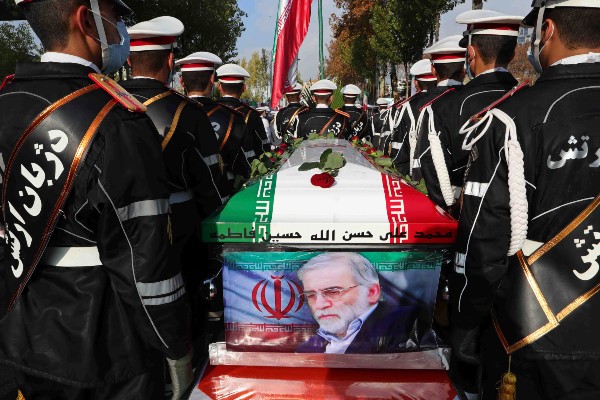Mohsen Fakhrizadeh, father of Iran’s nuclear program, was killed by a remotely operated sniper rifle assisted by artificial intelligence, according to the New York Times.
By Pesach Benson, United With Israel
Mohsen Fakhrizadeh, the father of Iran’s nuclear program, was put on notice in 2018. At a press event unveiling a warehouse full of Iranian nuclear documents stolen by the Mossad, Prime Minister Benjamin Netanyahu mentioned the name of the obscure scientist several times.
“Remember that name,” Netanyahu said. “Fakhrizadeh.”
Since 2007, the Mossad had managed to assassinate five Iranian nuclear scientists. The first was poisoned. Others were killed in their cars while idling in traffic when hitmen on motorcycles either fired fatal gunshots or attached bombs to their targets’ vehicles.
Fakhrizadeh was too important, though. He oversaw the Islamic Republic’s drive for nuclear weapons and its pursuit of making them small enough to fit on a missile. He was widely admired for procuring nuclear equipment despite international sanctions. Fakhrizadeh also held the rank of of Brigadier General in the Iranian Revolutionary Guards Corps, giving him clout rarely afforded to scientists.
So everywhere Fakhrizadeh went, he was accompanied by members of the Revolutionary Guards in convoys of 4-7 vehicles. They would be on the lookout for all kinds of threats, especially motorcycles. If the Mossad was going to kill Fakhrizadeh — and the Mossad wanted to do it before the end of Donald Trump’s presidency — the spy agency would have come up with a new way of reaching the seemingly untouchable Iranian.
In a widely-cited New York Times report, Ronen Bergman, an Israeli journalist with a track record of intelligence scoops, pieced together how the Mossad got Fakhrizadeh on a stretch of road not far from the Caspian Sea. It came down to Fakhrizadeh’s fatalism, security failures by his guards, and meticulous planning by the Mossad.
The Souped Up Sniper Rifle
According to the Times, killing Fakhrizadeh in an aerial drone strike like the US assassination of Revolutionary Guards commander Qasem Suleiman was out of the question. Any UAV large enough to fly the long distance between Israel and Iran would have been easily detectable. This also ruled out using a drone as an “eye in the sky” as the IDF surveils Gaza.
The Mossad settled on a remotely operated sniper rifle — which a few armies already have. “Israel chose a special model of a Belgian-made FN MAG machine gun attached to an advanced robotic apparatus, according to an intelligence official familiar with the plot. The official said the system was not unlike the off-the-rack Sentinel 20 manufactured by the Spanish defense contractor Escribano,” the Times reported.
It was capable of firing 600 rounds per minute.
Although the gun would be fired by a remote operator miles away, artificial intelligence was needed to compensate for technical problems that would have otherwise doomed the mission.
First, a machine gun’s recoil causes the gun to shake, throwing off the trajectory of subsequent bullets.
Also, The Times reported, “even though the computer communicated with the control room via satellite, sending data at the speed of light, there would be a slight delay: What the operator saw on the screen was already a moment old, and adjusting the aim to compensate would take another moment, all while Mr. Fakhrizadeh’s car was in motion.” This created a lag time of 1.6 seconds, “enough of a lag for the best-aimed shot to go astray.”
So artificial intelligence was brought in to compensate for the gun’s recoil, the 1.6 second time lag, and the speed of Fakhrizadeh’s car.
And instead of an eye in the sky, the Mossad would fake a disabled car at a traffic circle where Fakhrizadeh and his convoy would have to pass. That car would have its own camera and be situated less than a mile from the kill zone. The Mossad would know exactly in which car their target was and exactly where he was sitting.
The souped-up rifle weighed a ton and was smuggled into Iran in small pieces. The plan was to place it on the back of a pickup truck hidden among tarpaulin and construction supplies. The pickup would also be loaded with explosives in order to to self-destruct and leave no evidence behind.
Rain of Bullets
The Mossad’s operatives in Iran had set everything up. On Nov. 27, 2020, Fakhrizadeh’s convoy passed the traffic circle en route to a vacation villa in the nearby town of Absard. The gun’s operator could see the target was personally driving the second car in the convoy. Fakhrizadeh eschewed armored cars and personal drivers. According to The Times, the number of security threats he was warned about over the years made him fatalistic.
When the convoy passed the traffic circle, the first car sped ahead to inspect the house in Absard. Fakhrizadeh’s security detail would be in no position to protect its man.
The first barrage of bullets struck the front of the car, and it wasn’t clear if Fakhrizadeh was hit, the Times explained. After adjusting his sights, the operator fired again, hitting the scientist “at least once in the shoulder.” Fakrizadeh got out of the car, crouched behind the open front door, and was hit by three more bullets.
Fakhrzadeh’s closest guard ran up, unable to determine where the shots had come from. He arrived just in time for the blue pickup truck to explode.
But, according to The Times, the self-destruct was the only part of the mission that failed to go according to plan.
“The explosion was intended to rip the robot to shreds so the Iranians could not piece together what had happened. Instead, most of the equipment was hurled into the air and then fell to the ground, damaged beyond repair but largely intact.”
The Times added that operation took less than one minute, and a mere 15 bullets were fired.
Fakhrizadi’s wife, who was sitting beside her husband the whole time, was not hit.
